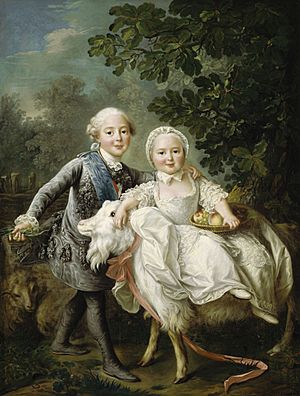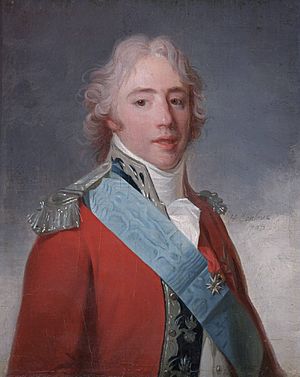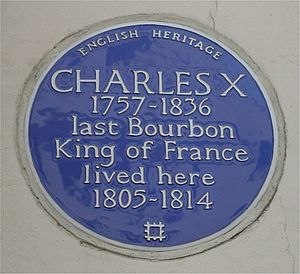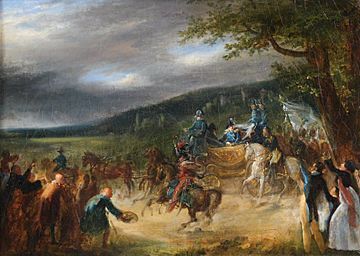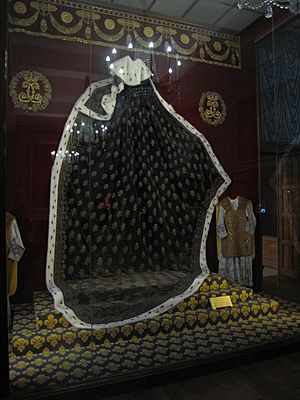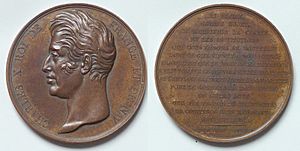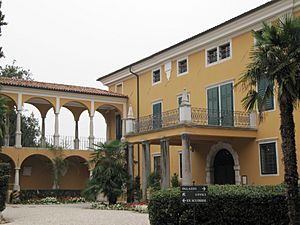Charles X facts for kids
Quick facts for kids Charles X |
|||||
|---|---|---|---|---|---|
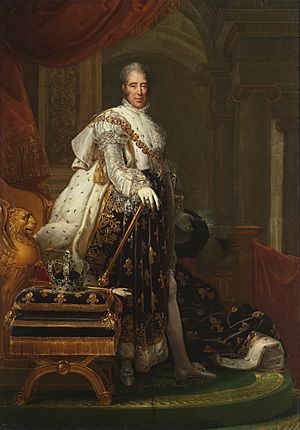
Portrait by François Gérard, c. 1825
|
|||||
| King of France (more...) | |||||
| Reign | 16 September 1824 – 2 August 1830 | ||||
| Coronation | 29 May 1825 Reims Cathedral |
||||
| Predecessor | Louis XVIII | ||||
| Successor | Louis Philippe I (as King of the French) | ||||
| Prime Ministers |
See list
|
||||
| Born | 9 October 1757 Palace of Versailles, France |
||||
| Died | 6 November 1836 (aged 79) Görz, Austrian Empire |
||||
| Burial | Kostanjevica Monastery, Slovenia | ||||
| Spouse | |||||
| Issue Detail |
Louis Antoine, Duke of Angoulême Sophie, Mademoiselle d'Artois Charles Ferdinand, Duke of Berry Marie Thérèse, Mademoiselle d'Angoulême |
||||
|
|||||
| House | Bourbon | ||||
| Father | Louis, Dauphin of France | ||||
| Mother | Marie-Josèphe of Saxony | ||||
| Religion | Catholicism | ||||
| Signature |  |
||||
Charles X (born Charles Philippe, Count of Artois; 9 October 1757 – 6 November 1836) was the King of France from 1824 to 1830. He was the uncle of the uncrowned Louis XVII and the younger brother of kings Louis XVI and Louis XVIII. Charles supported Louis XVIII during his time in exile.
After the Bourbon family returned to power in 1814, Charles became a leader of the ultra-royalists. This was a group of strong supporters of the monarchy. They believed kings ruled by God's will and opposed new freedoms for people. Charles gained more power after his son, Charles Ferdinand, Duke of Berry, was assassinated in 1820. He became king after his brother Louis XVIII died in 1824.
Charles X's reign lasted almost six years and was not popular with people who wanted more freedom. His coronation in 1825, where he tried to bring back old traditions, was seen as a step backward. His government paid back nobles who had lost land during the French Revolution. They also increased the power of the Catholic Church and brought back the death penalty for insulting sacred things. This led to arguments with the parliament, which had many members who wanted more liberal laws.
To distract from problems at home, Charles approved the French conquest of Algeria. He also made Haiti pay a large sum of money to recognize its independence. Eventually, he appointed a very conservative government, which lost support in the 1830 election. Charles responded with new rules called the July Ordinances. These rules closed down the parliament, limited who could vote, and stopped newspapers from printing freely.
Within a week, riots broke out in France, leading to the July Revolution of 1830. This forced Charles to give up his throne. Louis Philippe I was then chosen as the new King of the French. Charles went into exile again and died in 1836 in Gorizia, which was part of the Austrian Empire at the time. He was the last French ruler from the main branch of the House of Bourbon.
Contents
Early Life and Family
Charles Philippe of France was born in 1757 at the Palace of Versailles. He was the youngest son of Louis, the heir to the French throne, and his wife Marie Josèphe. His grandfather, King Louis XV, made him the Count of Artois at birth.
Since he was the youngest son, Charles was not expected to become king. However, his oldest brother, Louis, Duke of Burgundy, died in 1761. This moved Charles up one spot in the line of succession. He was cared for by Madame de Marsan, who was in charge of the royal children.
When his father died in 1765, Charles's oldest surviving brother, Louis Auguste, became the new Dauphin. Their mother, Marie Josèphe, died in 1767. This left Charles, at age nine, and his siblings as orphans.
In 1774, King Louis XV died, and his grandson Louis-Auguste became King Louis XVI.
Marriage and Children
In November 1773, Charles married Marie Thérèse of Savoy.
In 1775, Marie Thérèse gave birth to their first son, Louis Antoine. He was given the title Duke of Angoulême. Three years later, in 1778, their second son, Charles Ferdinand, was born. He became the Duke of Berry.
Charles was known for being the most charming member of his family. He was also a good friend of Queen Marie Antoinette. They enjoyed acting together in plays at her private theater. Marie Antoinette played country ladies, and Charles played lovers or farmers.
A famous story about Charles involves the Château de Bagatelle. In 1775, he bought a small hunting lodge. Marie Antoinette bet him that he couldn't rebuild it in three months. Charles hired the architect François-Joseph Bélanger, who finished the new building in just 63 days. The project, including beautiful gardens, cost a lot of money. Charles spent a lot during the 1770s and built up huge debts. In the 1780s, King Louis XVI paid off the debts of both his brothers.
French Revolution and Exile
Charles became more involved in politics during a big crisis for the monarchy in 1786. France was deeply in debt from past wars, like the Seven Years' War and the American Revolutionary War. The country needed money reforms to survive. Charles agreed that the nobles should lose some financial privileges. However, he did not want to reduce the special social rights of the Catholic Church or the nobility. He believed France's money problems should be fixed without overthrowing the monarchy.
King Louis XVI called a meeting of the Estates General in May 1789. This group had not met for over 150 years. Charles was one of the most conservative members of the royal family. He opposed the demands of the Third Estate, who wanted more voting power. His brother, the King, even said Charles was "more royalist than the king." In June 1789, the Third Estate declared themselves a National Assembly. They wanted to create a new constitution for France.
Charles tried to have the finance minister, Jacques Necker, removed. This plan backfired, and Necker's dismissal led to the storming of the Bastille on 14 July 1789. Three days later, Charles and his family left France with the King's approval. The King wanted Charles to be able to speak for the monarchy from outside France.
Life in Exile
Charles and his family found safety in Savoy, his wife's home country. Meanwhile, in Paris, King Louis XVI struggled with the National Assembly. In March 1791, a new law was passed about who would rule if the king died. This law completely ignored Charles's right to be regent.
Charles moved to Trier in Germany and planned to invade France to stop the Revolution. However, the royal family's attempt to escape Paris failed. Charles then moved to Koblenz. There, he and his brother, the Count of Provence, announced their plan to invade France. Other European rulers also called for action against France.
On 1 January 1792, the National Assembly declared that all French people who had left the country were traitors. They took away their noble titles and lands. The monarchy was later abolished in September 1792. The royal family was imprisoned, and the King and Queen were executed in 1793. The young heir to the throne died in 1795.
When the French Revolutionary Wars began in 1792, Charles escaped to Great Britain. King George III gave him money to live on. Charles lived in Edinburgh and London. His older brother, now called Louis XVIII, moved to other parts of Europe. In 1799, Charles's son Louis Antoine married Marie Thérèse, the only surviving child of Louis XVI. In 1807, Louis XVIII also moved to the United Kingdom.
Return to France
In January 1814, Charles secretly left London to join the armies fighting against Napoleon in southern France. His brother, Louis XVIII, made Charles the Lieutenant General of France. On 31 March, the Allied forces captured Paris, and Napoleon gave up his power a week later. The French Senate declared that the Bourbon monarchy would be restored, with Louis XVIII as King. Charles arrived in Paris on 12 April and acted as regent until Louis XVIII arrived from the United Kingdom. During this time, Charles created a secret police force that reported only to him.
Louis XVIII was welcomed joyfully in Paris. He moved into the Tuileries Palace. The King introduced a new constitution, the Charter of 1814. This charter created a two-part parliament, allowed about 90,000 men to vote, and guaranteed freedom of religion.
After Napoleon briefly returned to power in 1815, there was a period called the Second White Terror. This was a time when many officials who had supported Napoleon were removed from their jobs. About 70,000 officials were dismissed. Napoleon's army was broken up, and some of its leaders were punished or killed.
King's Brother and Heir
While King Louis XVIII kept the new constitution, Charles supported the "ultra-royalists" in parliament. These included figures like Jules de Polignac and Joseph de Villèle. Charles often disagreed with his brother's more liberal ministers. He even threatened to leave the country if the King did not dismiss them. Louis worried that his brother's strong royalist views would force the family into exile again.
On 14 February 1820, Charles's younger son, the Duke of Berry, was assassinated. This was a great sadness for the family and also put the future of the throne at risk. Charles's older son, the Duke of Angoulême, had no children. This meant the throne might pass to another branch of the family, which worried the conservative royalists.
However, the Duke of Berry's widow, Caroline, was found to be pregnant. On 29 September 1820, she gave birth to a son, Henry, Duke of Bordeaux. His birth was seen as a gift from God. People bought the Château de Chambord for him to celebrate his birth. King Louis XVIII gave him the title Count of Chambord.
Reign as King
Becoming King and Coronation
King Louis XVIII's health got worse in 1824. He died on 16 September at almost 69 years old. Charles, who was 66, became King Charles X. On 29 May 1825, Charles was crowned at the Reims Cathedral. This was the traditional place where French kings were crowned. It had not been used since 1775, as Louis XVIII had skipped the ceremony.
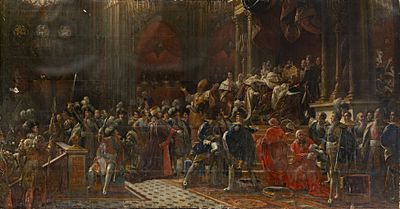
The coronation was a mix of old traditions and new ideas from the 1814 constitution. It included ancient rituals like the anointing with holy oil and oaths on the Gospels. But it also included an oath of loyalty to the 1814 Charter. A special group worked to simplify and update the ceremony. They removed parts that were no longer suitable, like promises to fight against heretics. The ceremony lasted three and a half hours.
Many royalists who supported a constitutional monarchy were happy about the coronation. They saw it as a link between the old monarchy and the new one. The writer François-René de Chateaubriand encouraged the king to be crowned. He believed it showed continuity with the past, not just a return to old ways.
The coronation lasted several days. On May 29, the main ceremony took place. Many important people, including writers Alphonse de Lamartine and Victor Hugo, were present. On May 31, the King performed the royal touch, a traditional healing ritual for scrofula.
The coronation of Charles X tried to combine old traditions with the political changes since the Revolution. However, many people did not fully understand or support it.
Policies at Home
Like previous rulers, Charles X mainly lived at the Tuileries Palace and the Château de Saint-Cloud. He also sometimes stayed at the Château de Compiègne and the Château de Fontainebleau. The Palace of Versailles, where he was born, remained empty.
Charles X's reign began with some liberal actions, like ending censorship of the press. However, he kept Joseph de Villèle as prime minister, who was a strong ultra-royalist. Charles gave the government control to the ultra-royalists.
He tried to connect with the public by traveling to northern and eastern France in 1827 and 1828. His oldest son and heir, the Duke of Angoulême, joined him.
One of Charles's first acts as king was to give his cousins, the House of Orléans, the title of Royal Highness. His brother Louis XVIII had not allowed them this title.
Charles's government passed laws to pay back nobles whose lands were taken during the Revolution. In April 1825, a law was approved to give about 988 million francs in government bonds to these former landowners. In the same month, the Anti-Sacrilege Act was passed. This law made insulting sacred things a crime punishable by death. Charles's government also tried to bring back a law where only the oldest son would inherit property, but this was rejected by parliament.
Charles was not popular in Paris, which had many liberal-minded people. This became clear in April 1827 during a review of the National Guard. There was chaos, and Charles disbanded the National Guard. However, their weapons were not taken away, so they remained a potential threat.
After losing his majority in parliament in November 1827, Charles dismissed Prime Minister Villèle. He appointed Jean Baptiste Gay, vicomte de Martignac, whom he saw as a temporary choice. In August 1829, Charles dismissed Martignac and appointed Jules de Polignac. Polignac also lost his majority in parliament, but he stayed in power and refused to call parliament back until March 1830.
Conquest of Algeria
On 31 January 1830, the Polignac government decided to send a military expedition to Algeria. The goal was to stop Algerian pirates who were threatening trade in the Mediterranean Sea. They also hoped a military victory would make the government more popular. The reason given for the war was that the ruler of Algeria had hit the French consul with a fly swat. French troops took control of Algiers on 5 July.
July Revolution
Parliament met on 2 March 1830, but Charles's opening speech was not well received. Many members of parliament disagreed with him. On 18 March, 221 members voted against the King's ministers. The King then decided to hold new elections, and parliament was suspended on 19 March.
The elections in June did not give the government a majority. On 6 July, the King and his ministers decided to suspend the constitution, as allowed in emergencies. On 25 July, at his royal home in Saint-Cloud, Charles issued four new rules, called the July Ordinances. These rules stopped newspapers from printing freely, dissolved the newly elected parliament, changed the voting system, and called for new elections.
The Ordinances were meant to calm public anger, but they did the opposite. Journalists protested, and on 26 July, a newspaper called Le Moniteur Universel published the new rules. A journalist named Adolphe Thiers published a call for revolt. Crowds gathered, shouting "Down with the Bourbons!" and "Long live the Charter!"
On 27 July, police raided and closed down newspapers. Protesters threw stones at soldiers, who then shot back. By evening, the city was in chaos. On 28 July, rioters built barricades in the streets. Marshal Auguste de Marmont tried to stop them, but some of his soldiers joined the rioters. He had to retreat to the Tuileries Palace.
Members of parliament asked Marmont to tell the King to calm the protesters by canceling the Ordinances. Marmont asked the prime minister, but Charles refused. He dismissed his ministers that afternoon. That evening, parliament members met and chose Louis Philippe I to take the throne from Charles. By the end of the day, Charles's government had lost all power.
Early on 31 July, Charles X decided to go to Versailles with his family. He was warned that Parisians planned to attack his home. Later that day, he moved to Rambouillet. On 2 August, King Charles X gave up his throne. He chose his grandson, Henry, Duke of Bordeaux, who was not yet ten years old, to be the next king. His son, the Dauphin, at first refused to sign the document giving up his own rights to the throne.
Louis Philippe ignored this document. On 9 August, he was declared King of the French by the parliament.
Second Exile and Death
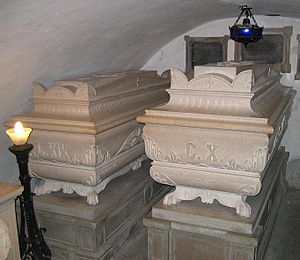
When it became clear that a large crowd was coming to attack, the royal family left Rambouillet. On 16 August, they sailed to the United Kingdom on ships provided by Louis Philippe. The British prime minister told them they had to arrive as private citizens. So, all family members used fake names. Charles X called himself "Count of Ponthieu." The British people were not very welcoming.
Charles X was soon followed to Britain by people he owed money to from his first exile. However, the family could use money Charles's wife had in London.
The Bourbons were allowed to live in Lulworth Castle and then moved to Holyrood Palace in Edinburgh. Charles had some disagreements with his daughter-in-law, the Duchess of Berry. She declared herself regent for her son Henry, who was now the rightful heir to the French throne in the eyes of many royalists. Charles eventually agreed to support her claim.
In 1831, the Duchess traveled to France and tried to start a rebellion against the new government. She was imprisoned, which embarrassed Charles. He was even more upset when she married a minor noble. Charles then stopped her from seeing her children.
In 1832, the Bourbons moved to Prague at the invitation of the Austrian Emperor. In September 1833, royalists gathered in Prague to celebrate the Duke of Bordeaux's thirteenth birthday. Charles X simply announced his grandson's coming of age.
After the Austrian Emperor died in 1835, the Bourbons left Prague. Charles moved to a warmer climate on Austria's coast in October 1835. He caught cholera in Görz (Gorizia) and died on 6 November 1836. He was buried in the Kostanjevica Monastery in Slovenia. Charles X is the only King of France to be buried outside the country.
There has been talk since 2016 about moving Charles X's remains to the Basilica of Saint-Denis in France, where other French monarchs are buried. However, the current head of the House of Bourbon stated in 2017 that he wished his ancestors' remains to stay where they are.
Honors and Titles
 Kingdom of France:
Kingdom of France:
- Knight of the Order of the Holy Spirit, 1 January 1771
- Grand Cross of the Legion of Honour, 3 July 1816
- Grand Cross of the Military Order of St. Louis, 10 July 1816
- Grand Master and Knight of the Order of St. Michael
- Grand Master and Grand Cross of the Order of St. Lazarus
 Austrian Empire: Grand Cross of the Order of St. Stephen, 1825
Austrian Empire: Grand Cross of the Order of St. Stephen, 1825 Denmark: Knight of the Order of the Elephant, 2 October 1824
Denmark: Knight of the Order of the Elephant, 2 October 1824 Netherlands: Grand Cross of the Military William Order, 13 May 1825
Netherlands: Grand Cross of the Military William Order, 13 May 1825 Kingdom of Prussia: Knight of the Order of the Black Eagle, 4 October 1824
Kingdom of Prussia: Knight of the Order of the Black Eagle, 4 October 1824 Russian Empire:
Russian Empire:
- Knight of the Order of St. Andrew, June 1815
- Knight of the Order of St. Alexander Nevsky, June 1815
 Kingdom of Saxony: Knight of the Order of the Rue Crown, 1827
Kingdom of Saxony: Knight of the Order of the Rue Crown, 1827 Spain: Knight of the Order of the Golden Fleece, 6 October 1761
Spain: Knight of the Order of the Golden Fleece, 6 October 1761 Two Sicilies:
Two Sicilies:
- Knight of the Order of St. Januarius
- Grand Cross of the Order of St. Ferdinand and Merit
 United Kingdom: Stranger Knight of the Order of the Garter, 9 March 1825
United Kingdom: Stranger Knight of the Order of the Garter, 9 March 1825
Children
Charles X married Princess Maria Teresa of Savoy in November 1773. She was the daughter of Victor Amadeus III, King of Sardinia.
They had four children, two sons and two daughters. Sadly, both daughters died in childhood. Only their oldest son lived longer than Charles. Their children were:
- Louis Antoine, Duke of Angoulême (born 1775 – died 1844). He married his cousin Marie Thérèse of France but had no children.
- Sophie, Mademoiselle d'Artois (born 1776 – died 1783). She died as a child.
- Charles Ferdinand, Duke of Berry (born 1778 – died 1820). He married Marie-Caroline de Bourbon-Sicile and had children.
- Marie Thérèse, Mademoiselle d'Angoulême (born 1783 – died 1783). She died as a baby.
In Movies
The Count of Artois is played by Al Weaver in the movie Marie Antoinette (2006).
Images for kids
See also
 In Spanish: Carlos X para niños
In Spanish: Carlos X para niños


